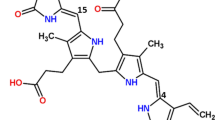Summary.
A crystal structure determination of a bilirubin analog (1) with an isopropyl group at C(10) is reported. Conformation determining torsion angles within the molecule and key hydrogen bond distances and angles are compared to those from molecular dynamics calculations and to the corresponding values from bilirubin X-ray determinations and molecular dynamics calculations. The crystal structure of 1 is very similar to that found by X-ray analysis of bilirubin and shows that 1 adopts a folded, intramolecularly hydrogen bonded ridge-tile conformation stabilized by six hydrogen bond. Taken collectively, the data indicate that even when a sterically demanding and potentially conformation distorting isopropyl group is located on the ridge-tile seam near the center of the molecule at C(10), intramolecular hydrogen bonding persists in the solid state. Like other bilirubins, the component dipyrrinones of 1 are present in the bis-lactam form with Z-configuration double bonds at C(4) and C(15).
Zusammenfassung.
Die Kristallstrukturbestimmung eines Bilirubinanalogons (1) mit einer Isopropylgruppe in Position C(10) wird mitgeteilt. Die konformationsbestimmenden Torsionswinkel innerhalb des Moleküls und wesentliche Wasserstoffbrückenbindungsdistanzen werden mit Resultaten aus Moleküldynamikrechnungen und den entsprechenden Werten aus Röntgenstrukturanalyse und Molekulardynamikrechnungen von Bilirubin verglichen. Die Kristallstruktur von 1 ist sehr ähnlich zu jener des Bilirubins und zeigt, daß1 eine gefaltete und intramolekular durch Wasserstoffbrückenbindungen vernetzte Firstziegelkonformation einnimmt, die durch sechs Wasserstoffbrücken stabilisiert wird. Insgesamt zeigen die Daten, daß trotz der sterisch anspruchsvollen und prinzipiell konformationsstörenden Isopropylgruppe, die an der Kante des Firstziegels nahe dem Molekülzentrum an C(10) angebracht ist, die intramolekulare Wasserstoffbrückenbindung im Festzustand erhalten bleibt. Wie in andern Bilirubinen liegen die Dipyrrinonkomponenten des Moleküls in der bis-Lactamform vor und weisen Z-konfigurierte Doppelbindungen an C(4) und C(5) auf.
Similar content being viewed by others
Author information
Authors and Affiliations
Additional information
Received January 28, 1999. Accepted February 16, 1999
Rights and permissions
About this article
Cite this article
Kar, A., Tipton, A. & Lightner, D. Crystal Structure and Conformation of a 10-Isopropyl Bilirubin. Monatshefte fuer Chemie 130, 833–843 (1999). https://doi.org/10.1007/PL00010265
Published:
Issue Date:
DOI: https://doi.org/10.1007/PL00010265




